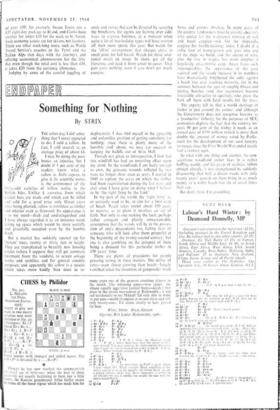CHESS by Philidor
No. 31o. L. MILLINS (1st Prize, Grantham Punta:,
1927)
WHITE to play and mate in two moves solution next week. Solution to No. 30t; (Trumpet): Kt x threat Kt x Kt. I ... KtxKt; 2 BxP 1 . . . Kt - K 5; 2 P— Q 4 (set Qx
EP). KxP; BLACK (9 men)
WHITE k,9 atm: Though he has now reached the comparatively advancei age of forty-one, when the fires of chess creativity are usually beginning to burn just a little lower, the Russian grandmaster Erfun Geller seems 10 retain all the fierce vigour which has made him for many years one of the greatest attacking players in the world. The following game—won against the almost equally aggressive Leonid Stein—decide.i first place in the recent tournament at Kislowodsk ; it was sad incidentally to see Mikhail Tal only able to make 50 per cent—world champion at twenty-three and still only twenty-nine. Tal seems clearly to have passed his best.
White, STEIN Black, GELLER Opening, RUY LOPEZ (Kislowodsk, 1966) r P- K 4 P- K 4
2 Kt - K B3 -Q B3 3 B- Kt 5 P - Q R3
4 13 - R 4 Kt - B3
5
6 R - Kr - (2 Kt 4 7 B - Kt 3 0 - 0 fiP- Q 4 . . . 8 P- B 3 allows the Marshall attack B • . . P - Q which Stein may have felt suited CiAlcr's style too well. Tax; may, however, be a little inferior objectively since it leads to a hoe in which Black is able to play B - K Kt 5, a move White normally prevents by P - K R 3. P - Q3
9 P-B 3 B-Keg ro P -Q g Kt - Q R 4
11 B - B P - B 3 P - K R 3 . . . An innovation P x P is usual. which I don't much like: White concedes Black something in the centre hoping to nreak his queen's side before Black can get a central adynice under way. More experience is needed to sea whether the idea is correct, but usually the man with the centre stands better.
BxKt 13 QxB PxP •
z4 PxP R - B z
t5 Kt- Q 2 P - Kt 3! 16 B-Q 3 . . . t6 P - Q R 4 at once is met by 16 . . .
l' - Kt 5.
r6 . . . Kt - R 4 r7 P-QR4 P-B 4
r8 PxPI . . . The idea; he will give a piece for three pawns hoping for the initiative as well. If he does not do this, Black wit: get the upper hand with P - K 5.
th' . . . P - IC 5
19 Kt x P PxKi
20 QxP Kt - Kt 6! Have a fourth pawn! 21 RxP Kt x B
22 R x Kt B - R 5
23 R - B 2 . . . Or 23 K - K B 1, Kt - B 5 followed by
Q - Kt 4 with a strong attack.
R - Q B2! 24 P- K Kt 3? . . . He should play 24 Q - K 6 ch! with an extremely critical position for both sides, ..g. 24 ... R(2) - B2; 25 R x P, Q - Kt 4 (threat Kt - B 5) and now (a) 26 B x P, P xB; 27 QxPch.Qx Q; 28 K x Q ch, K- K 2, and White will emerge with six pawns for two pieces! b; 26 Q - Kt 4, BxP ch; 27 R x13 (27 K -K 1?, 13 - Kt 6!), Q-B 8 oh; 28 K -R. 2, 12 x R; 29 B .., P, Q - B 5 oh; 3o QxQ, Kt x Q; 31 B - K 4, R x P, and Black should win. 24 • • • BxP!
25 PxB Q - Kt 4
26 P- K Kt 4 . . . Nothing better: with his other rook entering the attack by K - K a Black's pressure is too strong.
26 . . . lt - IC 2 27 Q - Q 4 Q - R 5
28 R - R r R-K8ch
29 RxR Q ., R ch 30 IC - R 2 12 - IC1 6 ch 31 K-R r Q xP ch
32 K- Kt r Kt - Kt 6!
33 Resigns • . . 33 . . . Q- R 8 mate is threatened; it R -K 4z_then 33 . . . R - B 8 mate or 33 R - R 2, R - B 8 a, al; 34 13 XX, QxB mate. A splendid game.














































 Previous page
Previous page